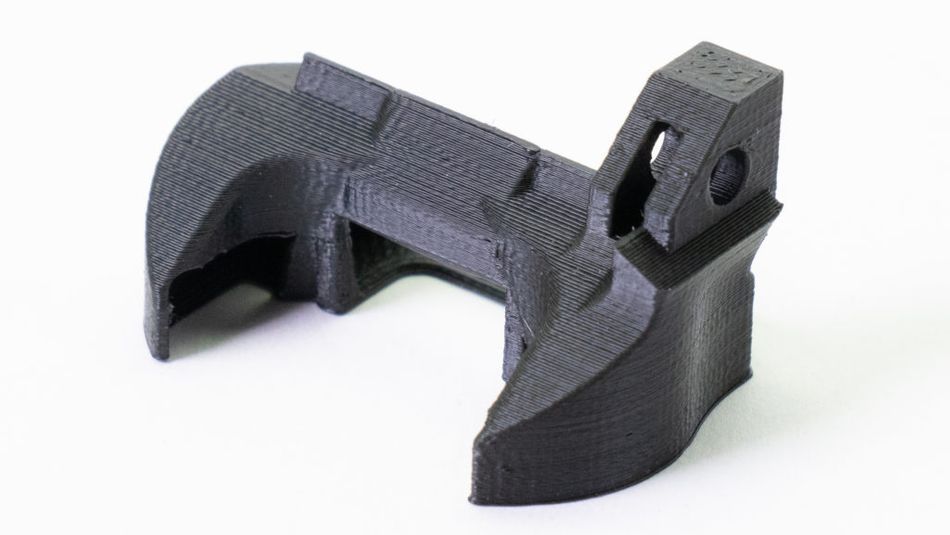ASA Glass Transition Temperature & Its Impact on 3D Printing
The ASA glass transition temperature is around 100°C. This makes it slightly easier to print than ABS, while it is also better for outdoor applications due to its good UV resistance.
Acrylonitrile Styrene Acrylate (ASA) filament has emerged as a popular choice in 3D printing, particularly for applications demanding both durability and resilience. As a copolymer, ASA combines the properties of acrylonitrile, styrene, and acrylate, resulting in a material that offers superior performance in challenging environments. One of the critical factors influencing ASA’s usability is its glass transition temperature (Tg), which plays a pivotal role in determining the filament's suitability for various applications.
The ASA glass transition temperature, typically about 100°C depending on the material and testing process, is a measure of the temperature at which the polymer transitions from a rigid, glassy state to a more flexible, rubbery state.[1] This property is crucial for assessing the material’s thermal stability and its ability to maintain structural integrity under heat. A high Tg indicates that ASA can withstand elevated temperatures without significant deformation, making it an ideal choice for parts exposed to heat or thermal cycles.
Additionally, the ASA glass transition temperature affects its performance in outdoor and high-stress environments. The ability of ASA to retain its mechanical properties and resist deformation at elevated temperatures contributes to its suitability for a range of applications, from automotive components to outdoor equipment.[2] This article goes over the basics of ASA glass transition temperature and its relevance to 3D printing.
What is ASA 3D Printing Filament?

Acrylonitrile Styrene Acrylate (ASA) is a widely used thermoplastic in FDM/FFF 3D printing, known for its excellent weather resistance, mechanical strength, and UV stability. Often compared to ABS (Acrylonitrile Butadiene Styrene), ASA offers similar strength and durability but with superior resistance to outdoor conditions, making it ideal for applications that require exposure to sunlight or harsh weather.
ASA’s UV stability prevents yellowing and degradation, ensuring that parts maintain their color and structural integrity over time. This property makes it a popular choice for automotive components, outdoor fixtures, and any application where prolonged exposure to the elements is a concern. Additionally, ASA is resistant to chemicals and has good impact strength, making it suitable for functional prototypes and end-use parts.
In terms of printability, ASA is less prone to warping compared to ABS, although it still requires a heated bed and an enclosed build chamber for optimal results. Its slightly lower shrinkage reduces the risk of warping, but careful attention to bed adhesion and temperature control is necessary to minimize these issues. ASA typically prints at temperatures between 240°C and 260°C, with a heated bed set around 90°C to 110°C. The use of an enclosure helps maintain consistent temperature, reducing the likelihood of warping and cracking.
ASA also supports post-processing, such as sanding, painting, and vapor smoothing, allowing for aesthetically pleasing and functional final products. However, one drawback is the emission of fumes during printing, similar to ABS, which requires adequate ventilation.
Recommended reading: ASA vs ABS: Finding the right 3D printing filament
ASA Glass Transition Temperature
The glass transition temperature (Tg) of Acrylonitrile Styrene Acrylate (ASA) is around 100°C, depending on the material and the testing process. This is a fairly high glass transition temperature compared to other low-cost 3D printing thermoplastics (but low compared to engineering plastics), making ASA particularly suitable for prototyping and low-risk applications where heat resistance and structural integrity are important.
For comparison, ABS, a close relative of ASA, has a Tg of about 105°C, slightly higher than ASA. Both materials behave similarly during printing, requiring heated beds and enclosed chambers to maintain temperatures above their Tg to ensure proper layer adhesion. However, ASA offers better UV and weather resistance, making it the preferred choice for outdoor applications.
On the other hand, PLA (Polylactic Acid), another widely used 3D printing material, has a much lower Tg of around 60°C. While PLA is easier to print due to its lower temperature requirements and minimal warping, its lower Tg limits its use in environments where higher temperatures are present. PLA parts can deform or soften under moderate heat, making them unsuitable for outdoor or high-heat applications where ASA would excel.
Comparatively, materials like PETG (Polyethylene Terephthalate Glycol) have a Tg around 80°C. PETG offers a good balance between ease of printing and heat resistance but lacks the UV stability of ASA, making ASA a better choice for outdoor parts that must endure sunlight and heat without degrading.
ASA’s Tg ensures that printed parts remain structurally stable and retain their mechanical properties in environments that would challenge lower Tg materials. However, designers must still consider ASA's limitations, ensuring that printed parts do not operate in conditions where temperatures exceed 100°C, as this could lead to softening and loss of strength.
Why Does ASA Glass Transition Temperature Vary?
The glass transition temperature (Tg) of ASA (Acrylonitrile Styrene Acrylate) can vary due to several factors related to its composition and processing conditions. ASA is a copolymer, meaning it is made from multiple monomers—acrylonitrile, styrene, and acrylate.[3] The ratios of these monomers can affect the Tg. Variations in the proportions can lead to differences in the polymer's rigidity and thermal properties.
Additionally, the presence of additives or fillers can influence the Tg. These can include impact modifiers, stabilizers, or colorants, each of which can alter the polymer’s thermal behavior. The manufacturing process also plays a crucial role; factors such as polymerization conditions, cooling rates, and thermal history can impact the final Tg. Variability in these conditions can result in slight changes in the Tg from one batch of ASA to another.
Finally, the Tg can be affected by the molecular weight of the polymer chains. Higher molecular weight ASA may exhibit a different Tg compared to lower molecular weight variants due to differences in chain entanglement and mobility. Thus, the glass transition temperature of ASA is not fixed but rather a range influenced by its specific formulation and processing history.
Thermal Properties of Different ASA Filament Brands

When 3D printing ASA filament, the ASA glass transition temperature is not necessarily the main property to focus on. This is due to a number of factors, but mainly because the extrusion temperature of a material is closer to its melting point than its glass transition temperature.
All filament manufacturers offer recommended printing temperatures for their ASA filament, as well as recommended bed temperatures. But many do not specify the glass transition temperature of the product, as it is less relevant for its end use. The table below shows the slight variations in ASA print settings between filament brands.
Brand | Glass Transition Temperature | Recommended Printing Temperature | Recommended Bed Temperature |
Prusament ASA | Not specified | 255°C - 265°C | 105°C - 115°C |
FormFutura ApolloX | 98°C | 235°C - 255°C | 80°C - 100°C |
Filamentum ASA extrafill | Not specified | 240°C - 255°C | 80°C - 105°C |
Polymaker PolyLite ASA | 97.8°C | 240°C - 260°C | 75°C - 95°C |
eSun ASA | Not specified | 240°C - 270°C | 90°C - 110°C |
High-Temperature Performance of 3D Printed ASA
3D printed ASA (Acrylonitrile Styrene Acrylate) is known for its good temperature resistance and UV resistance for its price point, making it a preferred material for outdoor and high-temperature applications. This property is also particularly advantageous for parts that undergo thermal cycling.
In terms of UV resistance, ASA excels compared to other common 3D printing materials like ABS. ASA’s chemical composition includes a high level of acrylate, which provides better protection against UV degradation. This makes ASA highly resistant to yellowing and physical degradation when exposed to sunlight, ensuring that printed parts retain their mechanical properties and aesthetic appearance over time. The inherent UV stability of ASA is beneficial for outdoor applications, such as automotive parts, construction components, and various outdoor equipment.
To enhance the heat resistance of ASA 3D prints, consider the following strategies:
Optimize Print Settings
Increase the extrusion temperature and print bed temperature to ensure better layer adhesion and reduce internal stresses. A higher nozzle temperature (typically between 240°C and 260°C) ensures the material is fully fused, leading to stronger, more heat-resistant prints. Slower print speeds can also improve inter-layer bonding, contributing to overall thermal stability.
Annealing
Post-process the ASA print by annealing it in an oven. Heating the print to a temperature just below the glass transition temperature (around 85°C to 95°C) for a few hours can relieve internal stresses and improve the crystallinity of the polymer. This process can enhance the print’s thermal resistance and dimensional stability when exposed to higher temperatures.
Infill and Wall Thickness Adjustment
Increase the infill percentage and wall thickness to reinforce the print. A denser infill and thicker walls create a more robust structure that can better resist deformation under heat. Additionally, using a higher number of perimeters can enhance the print’s rigidity, making it less susceptible to warping or softening when exposed to elevated temperatures.
Recommended reading: What is PLA Filament? Composition, Advantages, Applications
Conclusion

ASA's glass transition temperature (Tg) is an important parameter that influences its mechanical, thermal, and chemical properties. Understanding Tg is helpful for optimizing ASA's performance in diverse engineering applications, from automotive exteriors to electronic housings. However, ordinary 3D printer users should focus on a material’s suggested printing temperature rather than its glass transition temperature to achieve a high level of printing performance.
Frequently Asked Questions (FAQ)
What is the ASA glass transition temperature?
The glass transition temperature of ASA is around 100°C.
What is the ideal printing temperature for ASA?
ASA filament prints best at an extrusion temperature of around 250°C and a bed temperature of around 100°C.
How does ASA compare to ABS?
ASA has a slightly lower glass transition temperature than ABS. It is therefore fractionally less heat resistant but offers superior UV and water resistance.
What are some popular ASA filaments?
Common ASA filament brands include FormFuture ApolloX, Filamentum ASA extrafill, and Polymaker PolyLite ASA.
References
[1] Shen MC, Eisenberg A. Glass transitions in polymers. Rubber Chemistry and Technology. 1970 Jan 1;43(1):95-155.
[2] Berzinis A, Andriuli M. Weathering performance of black thermoplastic resins for unpainted automotive exterior applications. SAE transactions. 1999 Jan 1:706-15.
[3] Breulmann M. Synthesis, Properties and Applications of Acrylonitrile±Styrene±Acrylate Polymers. Modern Styrenic Polymers: Polystyrenes and Styrenic Copolymers. 2003 Mar 1:341.
Table of Contents
What is ASA 3D Printing Filament?ASA Glass Transition TemperatureWhy Does ASA Glass Transition Temperature Vary?Thermal Properties of Different ASA Filament BrandsHigh-Temperature Performance of 3D Printed ASAOptimize Print SettingsAnnealingInfill and Wall Thickness AdjustmentConclusionFrequently Asked Questions (FAQ)References
